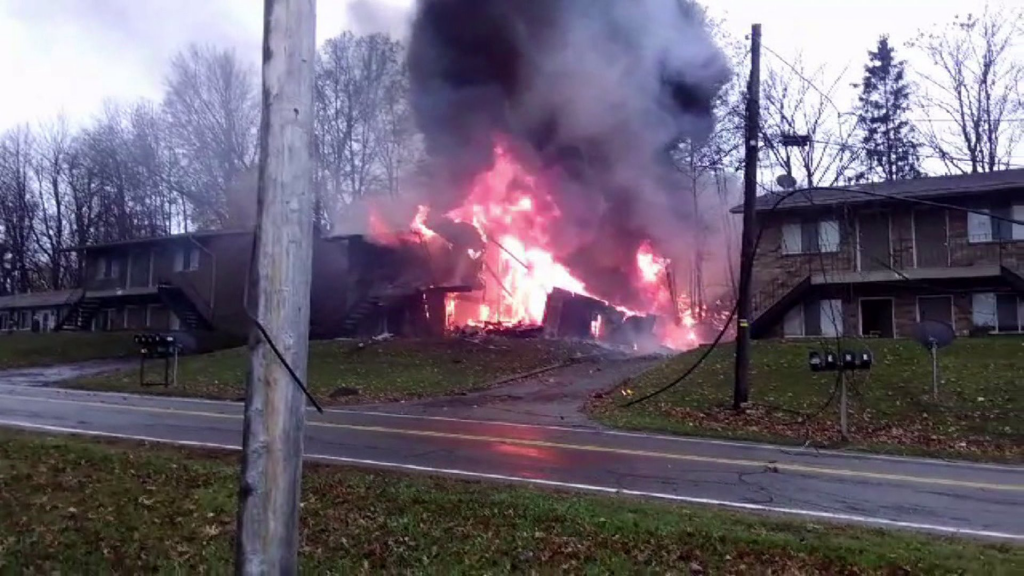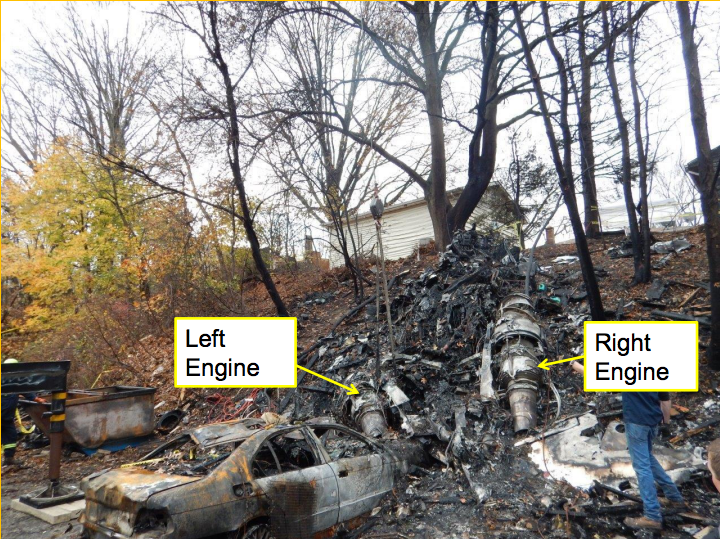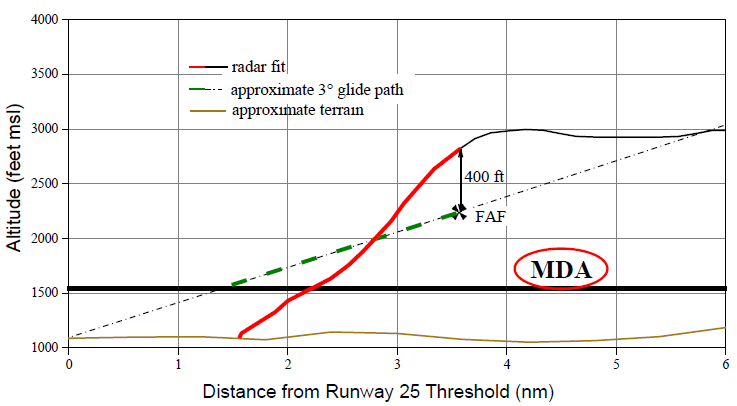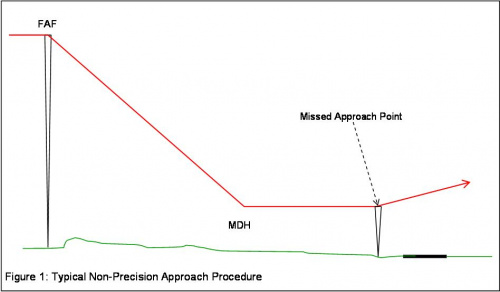Execuflight Hawker 700 N237WR Akron Accident: Casual Compliance
A disturbing accident after an unstabilised approach that begs serious questions of the operator’s procedures and culture.
On 10 November 2015, HS 125-700A (Hawker 700A) N237WR, operated by Fort Lauderdale based Execuflight under 14 CFR Part 135, suffered a Loss of Control In-flight (LOC-I) during a daytime Non-Precision Approach (NPA) to runway 25 at Akron Fulton International Airport (AKR), Ohio. See the US National Transportation Safety Board (NTSB) final report and the ATC audio.
The business jet impacted a four-unit apartment building near the airport and the 2 crew and 7 passengers died. No one on the ground was injured.
In his opening remarks NTSB Chairman Christopher Hart said:
A traveler boards an on-demand charter flight with the assumption that these government and company protections are in effect. However, in the accident that you will hear about today, we found a flight crew, a company, and FAA inspectors who fell short of their obligations in regard to safety.
The Accident Flight
The NTSB state in their report:
Although company standard operating procedures (SOPs) specified that the pilot flying was to brief the approach, the captain [the pilot monitoring] agreed to the first officer’s request that the captain brief the approach. The ensuing approach briefing was unstructured, inconsistent, and incomplete, and the approach checklist was not completed. As a result, the captain and first officer did not have a shared understanding of how the approach was to be conducted.
As the aircraft neared Akron:
…the approach controller instructed the flight to reduce speed because it was following a slower airplane on the approach. To reduce speed, the first officer began configuring the airplane for landing, lowering the landing gear and likely extending the flaps to 25° (the airplane was not equipped with a flight data recorder, nor was it required to be).
When the flight was about 4 nautical miles from the final approach fix (FAF), the approach controller cleared the flight for the localizer 25 approach and instructed the flight to maintain 3,000 ft mean sea level (msl) until established on the localizer. The airplane was already established on the localizer when the approach clearance was issued and could have descended to the FAF minimum crossing altitude of 2,300 ft msl. However, the first officer did not initiate a descent, the captain failed to notice, and the airplane remained level at 3,000 ft msl.
As the first officer continued to slow the airplane from about 150 to 125 knots, the captain made several comments about the decaying speed, which was well below the proper approach speed with 25° flaps of 144 knots.
The NTSB say this speed reduction risked an aerodynamic stall if the speed were to continue. to decay and suggest thatthe captain should have either taken control or call for a missed approach.
Before the airplane reached the FAF, the first officer requested 45° flaps and reduced power, and the airplane began to descend. The first officer’s use of flaps 45° was contrary to Execuflight’s Hawker 700A nonprecision approach profile, which required the airplane to be flown at flaps 25° until after descending to the minimum descent altitude (MDA) and landing was assured…
The airplane crossed the FAF at an altitude of about 2,700 ft msl, which was 400 ft higher than the published minimum crossing altitude of 2,300 ft msl.
Because the airplane was high on the approach, it was out of position to use a normal descent rate of 1,000 feet per minute (fpm) to the MDA. The airplane’s rate of descent quickly increased to 2,000 fpm, likely due to the first officer attempting to salvage the approach by increasing the rate of descent, exacerbated by the increased drag resulting from the improper flaps 45° configuration. The captain instructed the first officer not to descend so rapidly…
However as the decent continued:
…the captain did not make the required callouts regarding approaching and reaching the MDA, and the first officer did not arrest the descent at the MDA. When the airplane reached the MDA, which was about 500 ft above the touchdown zone elevation, the point at which Execuflight’s procedures dictated that the approach must be stabilized, the airspeed was 11 knots below the minimum required airspeed of 124 knots, and the airplane was improperly configured with 45° flaps.
Another opportunity to take control or call for a go-around (as per stabilised approach criteria) was missed.
About 14 seconds after the airplane descended below the MDA, the captain instructed the first officer to level off. As a result of the increased drag due to the improper flaps 45° configuration and the low airspeed, the airplane entered a stalled condition when the first officer attempted to arrest the descent. About 7 seconds after the captain’s instruction to level off, the cockpit voice recorder (CVR) recorded the first sounds of impact.
The impact forces of the accident were survivable for some occupants, but the immediate and rapidly spreading postcrash fire likely precluded the possibility of escape.
NTSB Observations
Among the other matters the NTSB commented on are:
The flight crew did not demonstrate effective crew resource management during the accident flight. Deficiencies in Execuflight’s crew resource management (CRM) training program, including the cursory review of CRM topics, the lack of appropriate evaluation of CRM examinations, and the lack of continual reinforcement of CRM principles, resulted in the flight crew receiving inadequate CRM training.
We note the so called CRM test that the first officer and captain had been set set was a laughable 10 question multiple choice questionnaire with minimal true CRM content (both scored 100%).
…the flight crew’s multiple deviations from standard operating procedures (SOPs) concerning weight and balance on each flight of the 2-day trip likely did not directly contribute to the accident, these deviations represent a pattern of routine disregard for SOPs.
Because Execuflight did not fully evaluate information it had concerning the first officer’s significant training difficulties at his previous employer, the company missed an opportunity to determine if the first officer was fully capable of operating its airplanes safely.
The captain had also been terminated from his previous employer (for not attending training).
Execuflight’s management had multiple opportunities to identify and correct the flight crew’s routine disregard for standard operating procedures regarding preflight planning but failed to do so.
Execuflight’s casual attitude towards compliance with standards illustrates a disregard for operational safety, an attitude that likely led its pilots to believe that strict adherence to standard operating procedures was not required.
The captain’s degraded performance during the flight was consistent with the effects of fatigue, but insufficient evidence exists about his normal sleep needs to determine whether he was fatigued at the time of the accident.
As a result of circadian disruption and Execuflight’s improper crew scheduling that did not provide the first officer with adequate rest for his preceding trip, the first officer was likely experiencing fatigue; however, the extent to which fatigue contributed to his deficient performance on the accident flight could not be determined.
The NTSB also mention the operator had an ‘informal’ policy that captains would be the pilot flying when passengers were on board. The NTSB do not comment on that, but it has been observed previously that co-pilots, when the pilot monitoring may be even less likely to speak up if an approach becomes unstabilised (for example).
Safety Issues Identified by NTSB
The NTSB identified the following safety issues:
1) Lack of a requirement for flight data monitoring programs for 14 CFR Part 135 operators
Execuflight had no means to monitor the daily operation of its airplanes, identify operational deficiencies (such as noncompliance with SOPs), and correct those deficiencies before an accident occurred. …the only means an operator can use to consistently and proactively monitor its line operations is through comprehensive data collection over the entirety of its operation, which can be accomplished through flight data monitoring.
The value of FDM was recently demonstrated by this National Business Aviation Association (NBAA) analysis: Business Aviation Compliance With Pre Take-off Flight Control Checks. NTSB Chairman Christopher Hart said:
Flight data monitoring can provide the fuel to drive continuous safety improvement… We recommended installing devices for flight data monitoring, to give company management the information necessary to evaluate and, if necessary, correct pilot behavior in order to prevent accidents such the one that we considered today.
2) Lack of a requirement for safety management system (SMS) programs for 14 CFR Part 135 operators
Execuflight lacked an SMS, which has been recognized in the industry as an effective way to establish and reinforce a positive safety culture and identify deviations from SOPs so that they can be corrected.
Hart commented on the importance of an SMS being: “an effective set of practices, not a binder full of disregarded procedures that sits unused on a shelf”. We have previously written about SMS Shelfware.
The US requirements for 14 CFR Part 5 SMS are limited to 14 CFR Part 121 operators (see: US Part 5 SMS Progress).
3) Lack of a Hawker 700- and 800-series NPA procedure that meets stabilized approach criteria and defines “landing assured.”
The step-down technique for executing nonprecision approaches taught to the flight crew required level off at the MDA and a flap configuration change at the point of “landing assured.”
Since many nonprecision approaches…have MDAs about 400 to 500 ft agl [this] entails a configuration change below 1,000 ft agl…contrary to one of the criteria for a stabilized approach provided in Federal Aviation Administration (FAA) Advisory Circular (AC) 120-71A, “Standard Operating Procedures for Flight Deck Crewmembers.”
Additionally, there is no definition of “landing assured,” and Hawker simulator instructors provided varying definitions, some of which appeared to conflict with the federal regulation regarding descending below the MDA [91.175(c)(1)] .
4) Lack of a requirement for flight crew training on the continuous descent final approach technique
FAA AC 120-108, “Continuous Descent Final Approach [CDFA],” describes and recommends the use of the CDFA technique in lieu of the step-down type of nonprecision approach that Execuflight pilots were trained to conduct.
A CFDA eliminates the multiple thrust, pitch, and altitude adjustments inside the FAF.
While the FAA “favours “the use of CDFA, it is only guidance and operators are not required to adopt the technique.
Execuflight training guidance did not specify the use of CDFA on nonprecision approaches. Although several CAE Simuflite instructors indicated that they may teach CDFA as a technique, there was no formal instruction on CDFA, and no formal instruction on using the CDFA technique was provided to Execuflight pilots before the accident.
5) Inaccuracy of data entered into weight-and-balance software
Execuflight pilots primarily computed weight and balance using a computer program:
Because an incorrect basic operating weight was entered into the program, the accident flight crew underestimated the airplane’s takeoff weight. Although the incorrect information did not adversely affect the airplane’s performance, this error highlights the importance of ensuring that software program data are current and accurate.
6) Inadequate FAA surveillance of 14 CFR Part 135 operators
The FAA principal operations inspector assigned to Execuflight relied primarily on Part 135 pilot-in-command line checks flown locally to conduct his operational oversight. However, line checks flown locally do not constitute the same evaluation…as en route inspections during normal line operations. The FAA considers en route inspections its most effective method of accomplishing its air transportation surveillance objectives and responsibilities but does not require inspectors of Part 135 operators to accomplish this critical surveillance activity.
The FAA is reported to have instituted a new approach to surveillance.
7) Inadequate CVR maintenance procedures
The aircraft was not required to have a Flight Data Recorder (FDR) but did have a 1989 Fairchild tape based CVR:
The 30-minute tape recovered from the airplane’s CVR was not damaged; however, the quality of all recorded channels was poor, due in large part to electrical interference, likely from the aircraft’s alternating current generator. Had an adequate functional test of the CVR been performed with the engines running or by downloading and reviewing CVR content from an actual flight, the CVR quality issue may have been detected and corrected.
NTSB Probable Cause
The NTSB determined that the probable cause was:
…the flight crew’s mismanagement of the approach and multiple deviations from company SOPs, which placed the airplane in an unsafe situation and led to an unstabilized approach, a descent below MDA without visual contact with the runway environment, and an aerodynamic stall.
Contributing to the accident were:
Execuflight’s casual attitude toward compliance with standards; its inadequate hiring, training, and operational oversight of the flight crew; the company’s lack of a formal safety program; and the FAA’s insufficient oversight of the company’s training program and flight operations.
NTSB Chairman Christopher Hart said:
These companies must either improve their practices or close their doors. All companies have a responsibility to follow the regulations and to actively manage safety in all facets of their operations.
Safety Recommendations
Nine recommendations are directed to the FAA, two to Textron Aviation (as the parent company of the Type Certificate Holder) and two to Hawker 700/800 training centres.
Other Indications of Organisational Culture
One former Execuflight pilot interviewed by investigators made alarming claims in his deposition. He alleged that one of the owners would become threatening if a pilot turned down a flight on safety / compliance grounds.
The pilot alleges multiple deficiencies in maintenance, and that he had (for example):
…written up the ITT gauges [on one aircraft] before and stuff like that… So, [after maintenance] I’m thinking everything is okay. But I’m coming in to Boca at night, Boca Raton, Florida, and I’m flying the airplane with one hand and I’ve got a rag in the other one, wiping the moisture off inside the window because the windshield heat is not working. And the ITT gauge quit working again. And I said something about it to him and I wrote it up.
I said well, I’m writing this on the flight sheet, on the flight log and I wrote it up. And two days, three days later, I get a phone call [from the CEO]. Well, you just grounded the airplane, blah, blah, blah. You know it is going to cost $14,000 to replace the window and so we have got to stop the bleeding [of money].
In a discussion about organisation’s culture the claims:
Money was the factor. You know, revenue was always the most important part, not safety…That is the way it always felt to me.
The pilot went on to allege that the company lied about the first officer’s reporting time prior to the accident and that as a representative to the NTSB investigation he had been asked to lie.
NTSB: “a few moments ago you were asked if you were ever asked to lie about any of the information provided to the NTSB. Were you ever asked to lie about the information we just gone over here (in this deposition)?”
Pilot: “Yes. There was a time that I felt like yes, that they were misleading the investigation”
He cited providing false weight and balance information as an example.
And just they made such a scramble to change records and eliminate stuff right after that accident, it would make your head spin.
Execuflight dispute the NTSB conclusions. ExecuFlight had said in a submission to the NTSB during the investigation that it had a “robust safety culture”. They offered no evidence to reinforce that assertion.
UPDATE 14 February 2017: NTSB Accident Report Highlights Charter Ops Audit Questions (see also p75 of the NTSB final report).
UPDATE 24 May 2017: This accident was discussed at a workshop at the European Business Aviation Convention & Exhibition (EBACE2017) in Geneva.
UPDATE 31 May 2017: The NTSB again observe the lack of SMS in Part 135 after the loss of de Havilland DHC-3 Otter floatplane, N270PA in a CFIT in Alaska and the loss of 9 lives: All Aboard CFIT: Alaskan Sightseeing Fatal Flight
UPDATE 6 June 2017: Lessons Learned From Execuflight Accident, Says Company President, Danny Lewkowicz.
The wrongful-death lawsuits against Execuflight have been settled, covered by the company’s insurance, but some property damage lawsuits remain pending, according to Lewkowicz, and these weren’t covered by Execuflight’s insurance.
According to Lewkowicz, the captain was not fired [from a previous job] but quit that job and did not want to impose the training cost on his employer if he was not going to continue working there.
“We were aware of [the co-pilots] past employment. He was fired from a company where he would have been flying an aircraft he had never before flown in the past (737). At the time, he had issues at home related to a complicated pregnancy. He was recommended to us by another active Execuflight pilot who was working with us and had flown with him many times and said he was a competent Hawker pilot and was highly recommending him. I’m not in agreement with those [NTSB] conclusions,” he said.
The company claims it has implemented an SMS.
For Execuflight flight operations, he said, “We’ve raised the minimums [of non-precision approaches practised] to be double the published number, and made it where it’s a continuous descent. If [pilots] level off then it’s an immediate go-around. We discourage quoting charters to airports that don’t have a precision approach.”
Lewkowicz persist with a claim that air traffic controllers should have notices the crew they were high at the Final Approach Fix. The crew however appear to have noticed as the descent rate steepened. The NTSB said “The air traffic controller’s handling of the flight was not a factor in this accident.”
Other Resources
Business Aviation Compliance With Pre Take-off Flight Control Checks
Aerossurance has previously written about safety culture including:
Also:
- Gulfstream G-IV Take Off Accident & Human Factors
- Fatal G-IV Runway Excursion Accident in France – Lessons
- Business Jet Collides With ‘Uncharted’ Obstacle During Go-Around
- Culture + Non Compliance + Mechanical Failures = DC3 Accident
- Wait to Weight & Balance – Lessons from a Loss of Control
- Fatal Night-time UK AW139 Accident Highlights Business Aviation Safety Lessons
- CFIT Gangnam Style – Korean S-76C++ and Decision Making
- Catastrophe in the Congo – The Company That Lost its Board of Directors
- UPDATE 30 October 2016: LOC-I Departure: AAIB Report on King Air 200 Accident
- UPDATE 24 April 2017: Unstabilised CL-600 Approach Accident at Aspen
- UPDATE 7 May 2017: Ground Collision Under Pressure: Challenger vs ATV: 1-0
- UPDATE 25 June 2017: During an air ambulance positioning flight in Iceland an Impromptu Flypast Leads to Disaster, begging more questions on organisational culture.
- UPDATE 29 October 2017: How a Cultural Norm Lead to a Fatal C208B Icing Accident
- UPDATE 7 April 2018: Investigators Criticise Cargo Carrier’s Culture & FAA Regulation After Fatal Somatogravic LOC-I. A Shorts 360 N380MQ, operated by SkyWay Enterprises as a Part 135 flight on contract to FedEx crashed in the Caribbean after the crew likely suffered a Somatogravic Illusion raising the flaps on a dark night in 2014. The lack of an FAA SMS regulation for Part 135, the operator’s poor safety culture and implications for the wider industry culture stand out in a thoughtful accident report.
- UPDATE 8 July 2018: Distracted B1900C Wheels Up Landing in the Bahamas
- UPDATE 9 July 2018: In a safety investigation report released last week, the TSB said that the operator of a survey Piper PA-31 Navajo C-FQQB, was unaware that the accident pilots “had frequently flown at very low altitudes” while transiting between survey areas and their base. The Navajo was flying between 40 ft and 100 ft AGL when it struck power cables on 30 April 2017. TSB reiterated a call for flight recorders on smaller aircraft.
- UPDATE 6 January 2020: Runway Excursion Exposes Safety Management Issues
- UPDATE 8 June 2020: Fatal Falcon 50 Accident: Unairworthy with Unqualified Crew
- UPDATE 4 October 2020: Investigators Suggest Cultural Indifference to Checklist Use a Factor in TAROM ATR42 Runway Excursion
- UPDATE 4 August 2022: DC3-TP67 CFIT: Result-Oriented Subculture & SMS Shelfware
Aerossurance is pleased to support and present at the Chartered Institute of Ergonomics & Human Factors’ (CIEHF) Human Factors in Aviation Safety Conference that takes place at the Radison Blu Hotel, East Midlands Airport, 7-8 November 2016.






Recent Comments